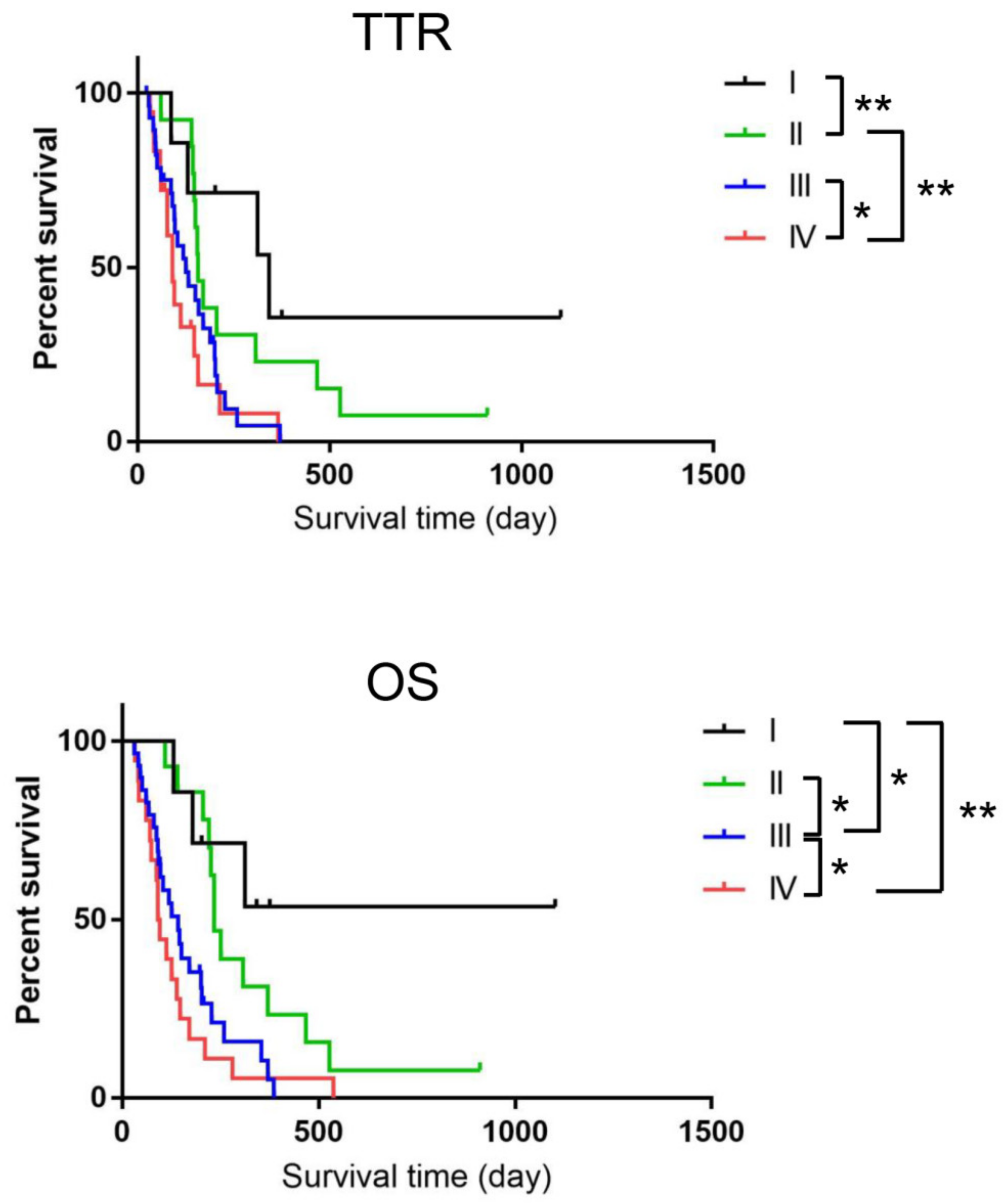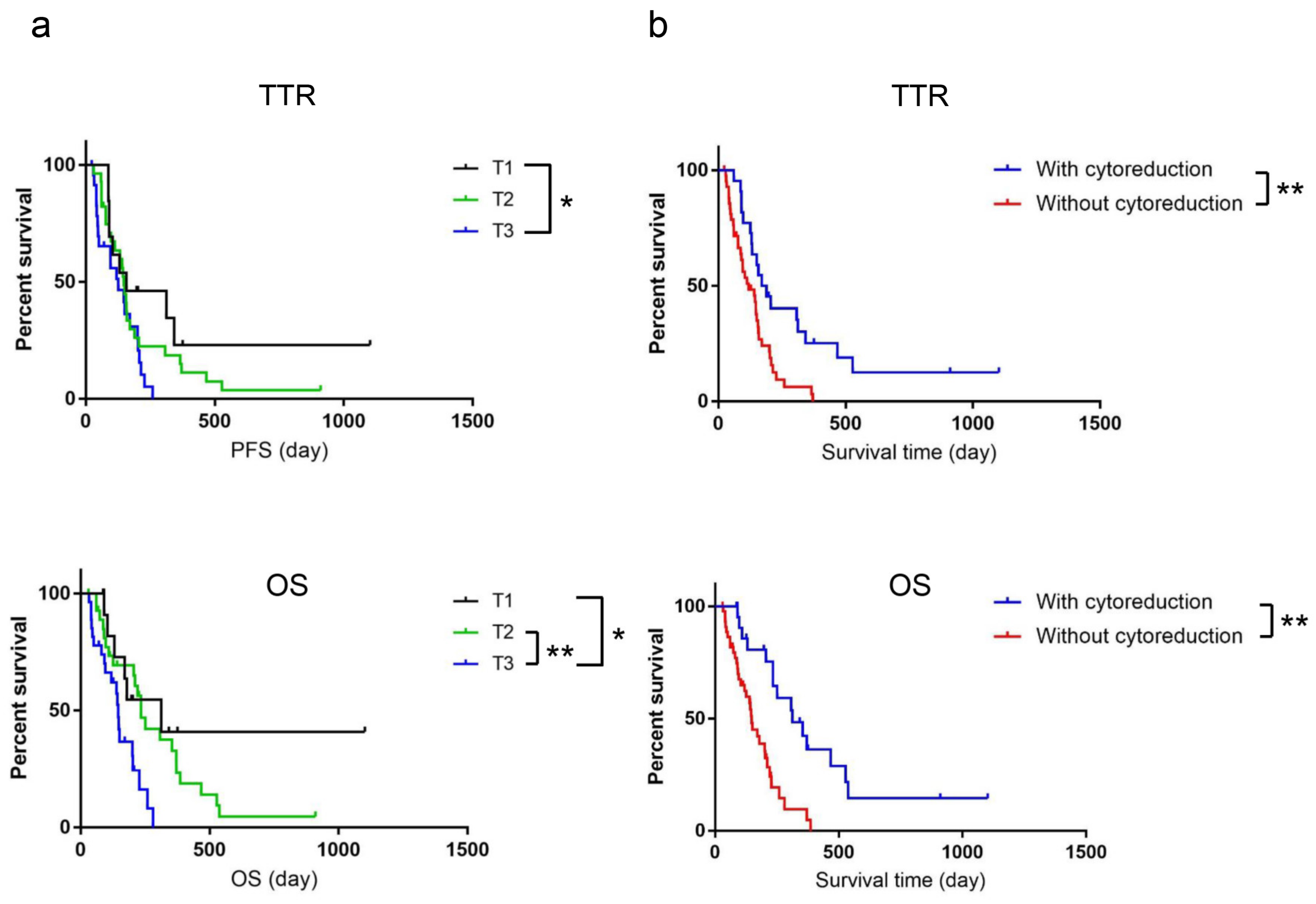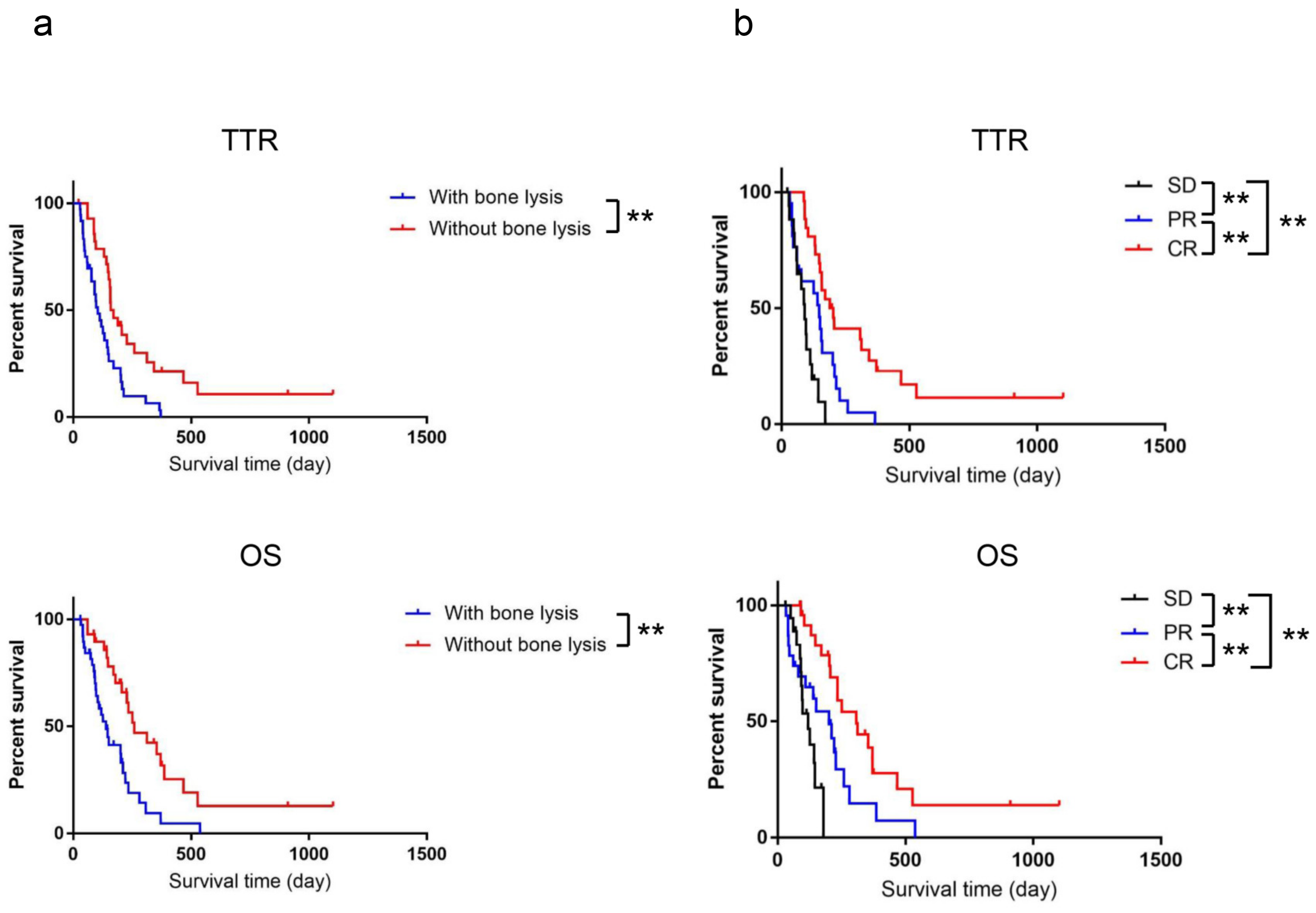Prognostic Factors for the Efficiency of Radiation Therapy in Dogs with Oral Melanoma: A Pilot Study of Hypoxia in Intraosseous Lesions
Abstract
Simple Summary
Abstract
1. Introduction
2. Materials and Methods
2.1. Case Selection
2.2. Medical Record Review
2.3. Evaluation of Clinicopathological Status
2.4. Radiation Therapy
2.5. Evaluation of Treatment Response
2.6. Immunohistochemistry
2.7. Statistics
3. Results
3.1. Patient Characteristics
3.2. Tumor Characteristics in Relation to Clinical Stage
3.3. Outcomes
3.4. HIF-1α Expression in Melanoma Tissues
4. Discussion
5. Conclusions
Supplementary Materials
Author Contributions
Funding
Institutional Review Board Statement
Informed Consent Statement
Data Availability Statement
Acknowledgments
Conflicts of Interest
Abbreviations
References
- Bergman, P.J.; Selmic, L.E.; Kent, M.S. Melanoma. In Withrow & MacEwen’s Small Animal Clinical Oncology, 6th ed.; Vaill, D.M., Thamm, D.H., Liptak, J.M., Eds.; Elsevier: St. Louis, MO, USA, 2020; pp. 367–381. [Google Scholar]
- Bergman, P.J. Canine oral melanoma. Clin. Tech. Small Anim. Pract. 2007, 22, 55–60. [Google Scholar] [CrossRef] [PubMed]
- Kawabe, M.; Mori, T.; Ito, Y.; Murakami, M.; Sakai, H.; Yanai, T.; Maruo, K. Outcomes of dogs undergoing radiotherapy for treatment of oral malignant melanoma: 111 cases (2006–2012). J. Am. Vet. Med. Assoc. 2015, 247, 1146–1153. [Google Scholar] [CrossRef] [PubMed]
- Baja, A.J.; Kelsey, K.L.; Ruslander, D.M.; Gieger, T.L.; Nolan, M.W. A retrospective study of 101 dogs with oral melanoma treated with a weekly or biweekly 6 Gy × 6 radiotherapy protocol. Vet. Comp. Oncol. 2022, 20, 623–631. [Google Scholar] [CrossRef] [PubMed]
- Proulx, D.R.; Dodge, R.K.; Hauck, M.L.; Williams, L.E.; Horn, B.; Price, G.S.; Thrall, D.E. A retrospective analysis of 140 dogs with oral melanoma treated with external beam radiation. Vet. Radiol. Ultrasound 2003, 44, 352–359. [Google Scholar] [CrossRef] [PubMed]
- Noguchi, S.; Ogusu, R.; Wada, Y.; Matsuyama, S.; Mori, T. PTEN, A Target of Microrna-374b, Contributes to the Radiosensitivity of Canine Oral Melanoma Cells. Int. J. Mol. Sci. 2019, 20, 4631. [Google Scholar] [CrossRef]
- Larue, S.M.; Gordon, I.K. Radiation oncology. In Withrow & MacEwen’s Small Animal Clinical Oncology, 6th ed.; Vaill, D.M., Thamm, D.H., Liptak, J.M., Eds.; Elsevier: St. Louis, MO, USA, 2020; pp. 209–230. [Google Scholar]
- Vaupel, P.; Mayer, A. Tumor Hypoxia: Causative Mechanisms, Microregional Heterogeneities, and the Role of Tissue-Based Hypoxia Markers. Adv. Exp. Med. Biol. 2016, 923, 77–86. [Google Scholar]
- Ward, J.F. DNA damage produced by ionizing radiation in mammalian cells: Identities, mechanisms of formation, and reparability. Prog. Nucleic Acid Res. Mol. Biol. 1988, 35, 95–125. [Google Scholar]
- Bendavid, J.; Modesto, A. Radiation therapy and antiangiogenic therapy: Opportunities and challenges. Cancer Radiother. 2022, 26, 962–967. [Google Scholar] [CrossRef]
- Suwa, T.; Kobayashi, M.; Shirai, Y.; Nam, J.M.; Tabuchi, Y.; Takeda, N.; Akamatsu, S.; Ogawa, O.; Mizowaki, T.; Hammond, E.M.; et al. SPINK1 as a plasma marker for tumor hypoxia and a therapeutic target for radiosensitization. JCI Insight 2021, 6, e148135. [Google Scholar] [CrossRef]
- Johnson, R.W.; Sowder, M.E.; Giaccia, A.J. Hypoxia and Bone Metastatic Disease. Curr. Osteoporos. Rep. 2017, 15, 231–238. [Google Scholar] [CrossRef]
- Nishikawa, K.; Seno, S.; Yoshihara, T.; Narazaki, A.; Sugiura, Y.; Shimizu, R.; Kikuta, J.; Sakaguchi, R.; Suzuki, N.; Takeda, N.; et al. Osteoclasts adapt to physioxia perturbation through DNA demethylation. EMBO Rep. 2021, 22, e53035. [Google Scholar] [CrossRef]
- Semenza, G.L. Hypoxia-inducible factors: Mediators of cancer progression and targets for cancer therapy. Trends Pharmacol. Sci. 2012, 33, 207–214. [Google Scholar] [CrossRef]
- Malekan, M.; Ebrahimzadeh, M.A.; Sheida, F. The role of Hypoxia-Inducible Factor-1alpha and Its signaling in melanoma. Biomed. Pharmacother. 2021, 141, 111873. [Google Scholar] [CrossRef]
- Semenza, G.L. Targeting HIF-1 for cancer therapy. Nat. Rev. Cancer 2003, 3, 721–732. [Google Scholar] [CrossRef]
- Hansen, A.E.; Kristensen, A.T.; Law, I.; Jørgensen, J.T.; Engelholm, S.A. Hypoxia-inducible factors--regulation, role and comparative aspects in tumourigenesis. Vet. Comp. Oncol. 2011, 9, 16–37. [Google Scholar] [CrossRef]
- Semenza, G.L. Defining the role of hypoxia-inducible factor 1 in cancer biology and therapeutics. Oncogene 2010, 29, 625–634. [Google Scholar] [CrossRef]
- Huang, Y.J.; Chen, Y.T.; Huang, C.M.; Kuo, S.H.; Liao, Y.Y.; Jhang, W.Y.; Wang, S.-H.; Ke, C.-C.; Huang, Y.-H.; Cheng, C.-M.; et al. HIF-1α Expression Increases Preoperative Concurrent Chemoradiotherapy Resistance in Hyperglycemic Rectal Cancer. Cancers 2022, 14, 4053. [Google Scholar] [CrossRef]
- Galeaz, C.; Totis, C.; Bisio, A. Radiation Resistance: A Matter of Transcription Factors. Front. Oncol. 2021, 11, 662840. [Google Scholar] [CrossRef]
- Shin, J.I.; Lim, H.Y.; Kim, H.W.; Seung, B.J.; Sur, J.H. Analysis of Hypoxia-Inducible Factor-1α Expression Relative to Other Key Factors in Malignant Canine Mammary Tumours. J. Comp. Pathol. 2015, 153, 101–110. [Google Scholar] [CrossRef]
- Madej, J.P.; Dziegiel, P.; Pula, B.; Nowak, M. Expression of hypoxia-inducible factor-1α and vascular density in mammary adenomas and adenocarcinomas in bitches. Acta Vet. Scand. 2013, 55, 73. [Google Scholar] [CrossRef]
- Kambayashi, S.; Igase, M.; Kobayashi, K.; Kimura, A.; Shimokawa, M.T.; Baba, K.; Noguchi, S.; Mizuno, T.; Okuda, M. Hypoxia inducible factor 1α expression and effects of its inhibitors in canine lymphoma. J. Vet. Med. Sci. 2015, 77, 1405–1412. [Google Scholar] [CrossRef] [PubMed]
- Nguyen, S.M.; Thamm, D.H.; Vail, D.M.; London, C.A. Response evaluation criteria for solid tumours in dogs (v1.0): A Veterinary Cooperative Oncology Group (VCOG) consensus document. Vet. Comp. Oncol. 2015, 13, 176–183. [Google Scholar] [CrossRef] [PubMed]
- Gola, C.; Iussich, S.; Noury, S.; Martano, M.; Gattino, F.; Morello, E.; Martignani, E.; Maniscalco, L.; Accornero, P.; Buracco, P.; et al. Clinical significance and in vitro cellular regulation of hypoxia mimicry on HIF-1α and downstream genes in canine appendicular osteosarcoma. Vet. J. 2020, 264, 105538. [Google Scholar] [CrossRef] [PubMed]
- Tutzauer, J.; Sjöström, M.; Holmberg, E.; Karlsson, P.; Killander, F.; Leeb-Lundberg, L.M.F.; Malmström, P.; Niméus, E.; Fernö, M.; Jögi, A. Breast cancer hypoxia in relation to prognosis and benefit from radiotherapy after breast-conserving surgery in a large, randomised trial with long-term follow-up. Br. J. Cancer 2022, 126, 1145–1156. [Google Scholar] [CrossRef] [PubMed]
- Zhu, H.; Zhang, S. Hypoxia inducible factor-1α/vascular endothelial growth factor signaling activation correlates with response to radiotherapy and its inhibition reduces hypoxia-induced angiogenesis in lung cancer. J. Cell. Biochem. 2018, 119, 7707–7718. [Google Scholar] [CrossRef]
- Zhong, H.; Chiles, K.; Feldser, D.; Laughner, E.; Hanrahan, C.; Georgescu, M.M.; Simons, J.W.; Semenza, G.L. Modulation of hypoxia-inducible factor 1alpha expression by the epidermal growth factor/phosphatidylinositol 3-kinase/PTEN/AKT/FRAP pathway in human prostate cancer cells: Implications for tumor angiogenesis and therapeutics. Cancer Res. 2000, 60, 1541–1545. [Google Scholar]
- Erler, J.T.; Bennewith, K.L.; Nicolau, M.; Dornhöfer, N.; Kong, C.; Le, Q.T.; Chi, J.T.; Jeffrey, S.S.; Giaccia, A.J. Lysyl oxidase is essential for hypoxia-induced metastasis. Nature 2006, 440, 1222–1226. [Google Scholar] [CrossRef]
- Finger, E.C.; Castellini, L.; Rankin, E.B.; Vilalta, M.; Krieg, A.J.; Jiang, D.; Banh, A.; Zundel, W.; Powell, M.B.; Giaccia, A.J. Hypoxic induction of AKAP12 variant 2 shifts PKA-mediated protein phosphorylation to enhance migration and metastasis of melanoma cells. Proc. Natl. Acad. Sci. USA 2015, 112, 4441–4446. [Google Scholar] [CrossRef]
- Yang, M.H.; Wu, M.Z.; Chiou, S.H.; Chen, P.M.; Chang, S.Y.; Liu, C.J.; Teng, S.C.; Wu, K.J. Direct regulation of TWIST by HIF-1alpha promotes metastasis. Nat. Cell. Biol. 2008, 10, 295–305. [Google Scholar] [CrossRef]




| Variable | Stage | p-Value | |||
|---|---|---|---|---|---|
| I (n = 7) | II (n = 14) | III (n = 29) | IV (n = 18) | ||
| Median body weight (kg) | 7.5 | 6.3 | 5.4 | 4.7 | N. S. |
| Age (years) | N. S. | ||||
| Median | 14 | 13.5 | 13 | 13 | |
| Mean ± SD | 13.4 ± 2.2 | 12.2 ± 3.4 | 12.7 ± 2.0 | 13.1 ± 1.6 | |
| Sex | N. S. | ||||
| Male | 4 | 3 | 18 | 4 | |
| Female | 3 | 11 | 11 | 14 | |
| Tumor location | N. S. | ||||
| Maxilla | 2 | 2 | 13 | 6 | |
| Mandible | 2 | 9 | 11 | 8 | |
| Rostral | 1 | 0 | 2 | 2 | |
| Bucca/Lip/Palate | 2 | 3 | 3 | 2 | |
| Bone lysis (%) | 0 (0) | 5 (55.6) | 20 (69.9) | 14 (77.8) | 0.00052 |
| Cytoreduction (%) | 5 (71.4) | 10 (71.4) | 6 (20.7) | 1 (5.6) | 0.00003 |
| TTR | OS | |||
|---|---|---|---|---|
| Variable | HR (95% CI) | p-Value | HR (95% CI) | p-Value |
| Clinical stage | 1.506 (1.038–2.186) | 0.0312 * | 1.583 (1.026–2.444) | 0.038 * |
| Tumor size | 0.972 (0.602–1.570) | 0.909 | 1.158 (0.667–2.012) | 0.603 |
| Cytoreduction | 0.969 (0.406–2.312) | 0.943 | 1.004 (0.374–2.693) | 0.994 |
| Bone lysis | 1.057 (0.497–2.244) | 0.886 | 1.164 (0.531–2.552) | 0.704 |
| Response | 1.869 (1.166–2.997) | 0.00937 * | 1.825 (1.060–3.140) | 0.0299 * |
| Sample | Breed | Sex | Age (years) | Body Weight (kg) | Location | Clinical Stage | Bone Lysis |
|---|---|---|---|---|---|---|---|
| 1 | Shiba | M | 15 | 9.1 | Mandible | II | Yes |
| 2 | Toy poodle | SF | 12 | 5 | Maxilla | I | Yes |
| 3 | Miniature dachshund | SF | 12 | 4.2 | Maxilla | III | Yes |
| 4 | Toy poodle | SF | 15 | 4 | Mandible | III | Yes |
| 5 | Mniature schnauzer | SF | 8 | 5.9 | Maxilla | III | Yes |
Disclaimer/Publisher’s Note: The statements, opinions and data contained in all publications are solely those of the individual author(s) and contributor(s) and not of MDPI and/or the editor(s). MDPI and/or the editor(s) disclaim responsibility for any injury to people or property resulting from any ideas, methods, instructions or products referred to in the content. |
© 2022 by the authors. Licensee MDPI, Basel, Switzerland. This article is an open access article distributed under the terms and conditions of the Creative Commons Attribution (CC BY) license (https://creativecommons.org/licenses/by/4.0/).
Share and Cite
Noguchi, S.; Yagi, K.; Okamoto, N.; Wada, Y.; Tanaka, T. Prognostic Factors for the Efficiency of Radiation Therapy in Dogs with Oral Melanoma: A Pilot Study of Hypoxia in Intraosseous Lesions. Vet. Sci. 2023, 10, 4. https://doi.org/10.3390/vetsci10010004
Noguchi S, Yagi K, Okamoto N, Wada Y, Tanaka T. Prognostic Factors for the Efficiency of Radiation Therapy in Dogs with Oral Melanoma: A Pilot Study of Hypoxia in Intraosseous Lesions. Veterinary Sciences. 2023; 10(1):4. https://doi.org/10.3390/vetsci10010004
Chicago/Turabian StyleNoguchi, Shunsuke, Kohei Yagi, Nanako Okamoto, Yusuke Wada, and Toshiyuki Tanaka. 2023. "Prognostic Factors for the Efficiency of Radiation Therapy in Dogs with Oral Melanoma: A Pilot Study of Hypoxia in Intraosseous Lesions" Veterinary Sciences 10, no. 1: 4. https://doi.org/10.3390/vetsci10010004
APA StyleNoguchi, S., Yagi, K., Okamoto, N., Wada, Y., & Tanaka, T. (2023). Prognostic Factors for the Efficiency of Radiation Therapy in Dogs with Oral Melanoma: A Pilot Study of Hypoxia in Intraosseous Lesions. Veterinary Sciences, 10(1), 4. https://doi.org/10.3390/vetsci10010004






